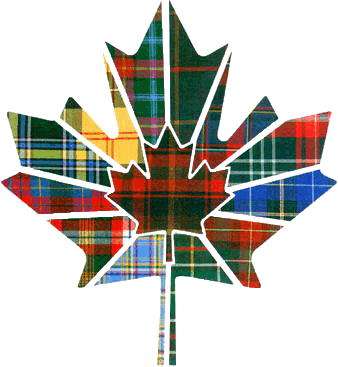
All of Canada's provinces and territories, except for Nunavut, have regional tartans, as do many other regional divisions in Canada. The first province to adopt one officially was Nova Scotia in 1955, and the most recent province was Ontario, in 2000. Except for the tartan of Quebec, all of the provincial and territorial tartans are officially recognized and registered in the books of the Court of the Lord Lyon, King of Arms of Scotland, also with the Scottish Register of Tartans at www.tartanregister.gov.uk
The official tartan for Canada as a whole is the Maple Leaf tartan.
| 1. Maple leaf 2. Newfoundland and Labrador 3. Prince Edward Island 4. Nova Scotia 5. New Brunswick 6. Quebec 7. Ontario 8. Manitoba 9. Saskatchewan 10. Alberta 11. British Columbia 12. Northwest Territories 13. Yukon |
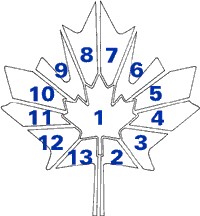 |
| Alberta The idea for Alberta's official tartan began in 1961 at the Edmonton Rehabilitation Society, a charitable organization set up to teach useful skills to the disabled. The tartan was designed by Alison Lamb, the Society's director, and Ellen Neilsen, the weaving instructor, and was officially adopted by the province in an Act of the Legislature on March 30, 1961. The green represents the province's forests, while the gold represents its grain fields. The shade of blue, as well as the gold, are also Alberta's provincial colours. Its International Tartan Index number is 2055. |
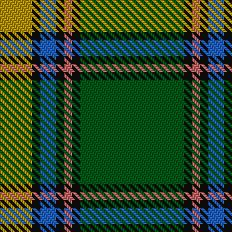 |
| British Columbia British Columbia's official tartan was designed by Eric Ward in 1966, to celebrate the 100th anniversary of the 1866 union of Vancouver Island and British Columbia. Its main colours are blue and red, representing the Pacific Ocean and the maple leaf, and also contains green for forests, white for the province's official flower, the Pacific Dogwood, and gold from the coat of arms. Its International Tartan Index number is 808. |
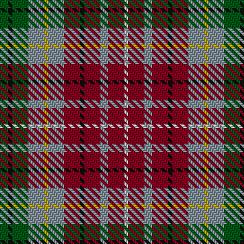 |
| Manitoba Manitoba's official tartan was designed in 1962 by Hugh Kirkwood Rankine, and officially adopted by the province in "The Coat of Arms, Emblems and the Manitoba Tartan Act", which received Royal Assent on May 1 of that year. The red in the design originates from the Red River Settlement, founded in 1812 by the Earl of Selkirk, Thomas Douglas, and crofters from the Scottish Highlands, and the blue was taken from the Clan Douglas tartan. In addition, the green lines represent the varying cultures and races that make up Manitoban society, and the gold represents Manitoba's agricultural history. Its International Tartan Index number is 144. |
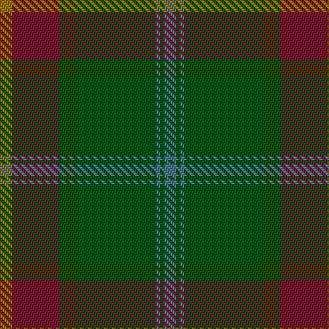 |
| New Brunswick The official tartan of New Brunswick was commissioned by William Aitken, Lord Beaverbrook in 1959 and designed by the Loomcrofters in Gagetown, New Brunswick. It was officially adopted as the provincial tartan by an Order in Council in the same year. The "beaver brown" colour was included to honour Beaverbrook, and the red honours the courage and loyalty of the New Brunswick Regiment and Loyalist settlers. Its International Tartan Index number is 1880. |
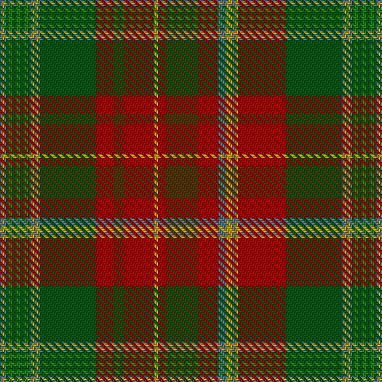 |
| Newfoundland and Labrador The tartan of Newfoundland and Labrador.The official tartan of Newfoundland and Labrador was designed in 1955 by Samuel B. Wilansky, a local store owner on Water Street in St. John's. It was registered in the Court of the Lord Lyon in 1973. The white, gold, and yellow come from the province's official anthem, "Ode to Newfoundland": When sun rays crown thy pine clad hills And summer spreads her hand When silvern voices tune thy rills We love thee, smiling land ... When spreads thy cloak of shimmering white At winter's stern command Thro' shortened day, and starlit night We love thee, frozen land. The green represents the pine forests, the white represents snow, the brown represents the Iron Isle, and the red represents the Royal Standard. Its International Tartan Index number is 1543. |
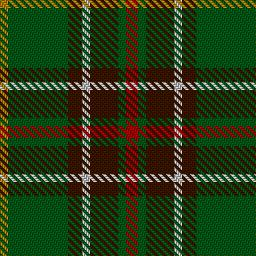 |
| Nova Scotia Nova Scotia's tartan. Nova Scotia's tartan was designed by Bessie Murray, the President of the Halifax Weavers' Guild. She had originally displayed the tartan on the kilt of a shepherd in a panel at a breeders' convention in Truro in 1953, but the design was so admired that is was afterwards used as the province's tartan. It was registered at the Court of the Lord Lyon in 1956, making it the first provincial tartan in Canada, and officially adopted by the province in the Nova Scotia Tartan Act of 1963. Blue is used for the sea; white, for the granite rocks and surf; gold, for the Royal Charter; and red for the lion rampant on the provincial flag. Its International Tartan Index number is 1713. |
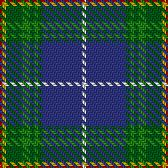 |
| Northwest Territories The idea of an official tartan for Northwest Territories was proposed by Janet Anderson-Thomson after she attended an RCMP ball in 1966 and noticed that the piper was, as she later described it, "terribly drab". She and her husband John, a land surveyor, both discussed the idea with Stuart Hodgson, then Commissioner of Northwest Territories, who supported it. The design was then created by Hugh MacPherson (Scotland) Limited of Edinburgh, a tartan designer and manufacturer, with Anderson-Thomson's colour suggestions: green for the forests, white for the Arctic Ocean, blue for the Northwest Passage, gold for the territories' mineral wealth, red-orange for autumn foliage, and a thin black line to represent the tree line. The tartan was registered at the Court of the Lord Lyon in 1972, and officially adopted by the Territorial Council in January 1973. Its International Tartan Index number is 662. |
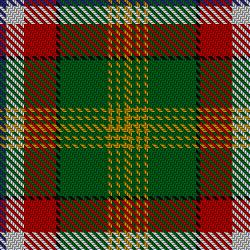 |
| Ontario Ontario's official tartan was designed in 1965 by Rotex Ltd, but not officially adopted by the province until 2000, when MPP for Bruce-Grey-Owen Sound Bill Murdoch introduced the Tartan Act, which received Royal Assent on June 23, 2000. The three shades of green represent Ontario's forests and fields; the red, its natives; the blue, its waters; and the white, the sky. Its International Tartan Index number is 6627. |
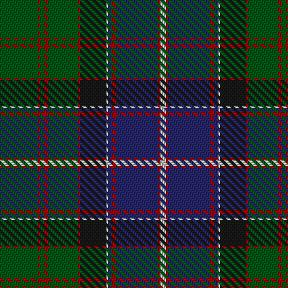 |
| Prince Edward Island Designed by Jean Reed of Covehead, the official tartan of Prince Edward Island was selected through a contest across the province, and adopted on June 16, 1960. The red-brown represents the famous red soil, the green is for the grass and trees, the white is for the surf, and the yellow is for the sun. Its International Tartan Index number is 918. |
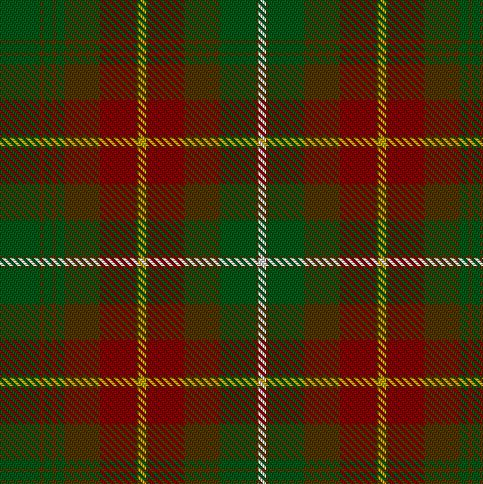 |
| Quebec Quebec is the only province whose tartan has not been officially adopted. Known as the Plaid of Quebec (French: Plaid du Québec), it was designed in 1965 by Rotex Ltd, which also designed the tartan of Ontario in the same year. Its colours are derived from the province's coat of arms, with blue from the upper division, green for the three maple leaves, red from the centre division, gold for the crown and lion passant, and white for the scroll containing the province's motto, Je me souviens (English: "I remember"). Its International Tartan Index number is 1949. |
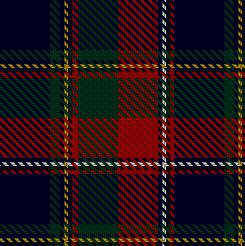 |
| Saskatchewan Saskatchewan's tartan was created in 1961 by Mrs. Frank Bastedo, wife of Frank Lindsay Bastedo, former Lieutenant Governor of Saskatchewan. The predominantly yellow palette is meant to represent Saskatchewan's identity as the "breadbasket" of Canada, with gold for wheat and yellow for rapeseed and sunflower. The other colours are green for forests, red for the prairie lily, white for snow, brown for summerfallow, and black for oil and coal. Its International Tartan Index number is 1817. |
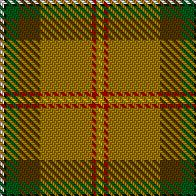 |
| Yukon The official tartan of Yukon was designed by Janet Couture of Faro in 1965. Its unique colour palette represents various aspects of Yukon's culture: yellow for the Klondike Gold Rush and midnight sun, purple for its mountains, white for snow, blue for water, and green for forests. It was first proposed as the territorial tartan in 1967, during the Canadian Centennial, but was not officially adopted until 1984, when the Yukon Tartan Act was passed by the Yukon Legislative Assembly. Its International Tartan Index number is 2129. |
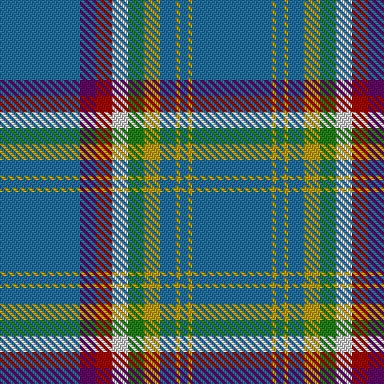 |
| The Maple Leaf Tartan The Maple Leaf Tartan was approved as an official symbol of Canada on March 9, 2011 by Honourable James Moore, Minister of Canadian Heritage and Official Languages. The Canadian Maple Leaf tartan was designed by David Weiser in 1964 in anticipation of the centenary of the granting of Dominion status to Canada in 1967. The name Maple Leaf was chosen as Maples are indigenous to Canada and the leaf, a symbol of nationhood, forms the central feature of the Canadian Flag, introduced in 1965. It was designed as a commercial venture by a Canadian, who had been in the fashion world for many years. In the words of the Commercial Division of the Office of the High Commissioner for Canada - "In creating the Maple Leaf Tartan fabric, David Weiser captured the natural phenomena of these leaves turning from summer into autumn. The green is the early colour of the foliage. Gold appears at the turn of autumn. Red shows up at the coming of the first frost. The two tones of brown find their way throughout the leaf creating a prolific profusion of colour." Its International Tartan Index number is 2034. |
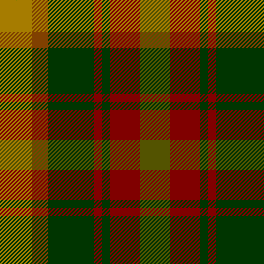 |